2016 NISSAN 370Z COUPE cooling
[x] Cancel search: coolingPage 355 of 428
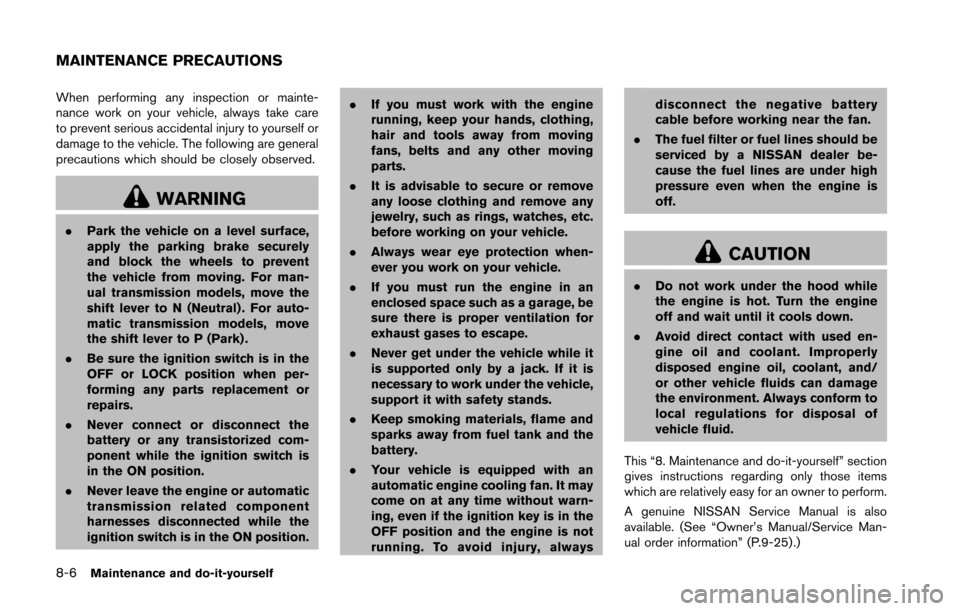
8-6Maintenance and do-it-yourself
When performing any inspection or mainte-
nance work on your vehicle, always take care
to prevent serious accidental injury to yourself or
damage to the vehicle. The following are general
precautions which should be closely observed.
WARNING
.Park the vehicle on a level surface,
apply the parking brake securely
and block the wheels to prevent
the vehicle from moving. For man-
ual transmission models, move the
shift lever to N (Neutral) . For auto-
matic transmission models, move
the shift lever to P (Park) .
. Be sure the ignition switch is in the
OFF or LOCK position when per-
forming any parts replacement or
repairs.
. Never connect or disconnect the
battery or any transistorized com-
ponent while the ignition switch is
in the ON position.
. Never leave the engine or automatic
transmission related component
harnesses disconnected while the
ignition switch is in the ON position. .
If you must work with the engine
running, keep your hands, clothing,
hair and tools away from moving
fans, belts and any other moving
parts.
. It is advisable to secure or remove
any loose clothing and remove any
jewelry, such as rings, watches, etc.
before working on your vehicle.
. Always wear eye protection when-
ever you work on your vehicle.
. If you must run the engine in an
enclosed space such as a garage, be
sure there is proper ventilation for
exhaust gases to escape.
. Never get under the vehicle while it
is supported only by a jack. If it is
necessary to work under the vehicle,
support it with safety stands.
. Keep smoking materials, flame and
sparks away from fuel tank and the
battery.
. Your vehicle is equipped with an
automatic engine cooling fan. It may
come on at any time without warn-
ing, even if the ignition key is in the
OFF position and the engine is not
running. To avoid injury, always disconnect the negative battery
cable before working near the fan.
. The fuel filter or fuel lines should be
serviced by a NISSAN dealer be-
cause the fuel lines are under high
pressure even when the engine is
off.
CAUTION
.Do not work under the hood while
the engine is hot. Turn the engine
off and wait until it cools down.
. Avoid direct contact with used en-
gine oil and coolant. Improperly
disposed engine oil, coolant, and/
or other vehicle fluids can damage
the environment. Always conform to
local regulations for disposal of
vehicle fluid.
This “8. Maintenance and do-it-yourself” section
gives instructions regarding only those items
which are relatively easy for an owner to perform.
A genuine NISSAN Service Manual is also
available. (See “Owner’s Manual/Service Man-
ual order information” (P.9-25).)
MAINTENANCE PRECAUTIONS
Page 357 of 428
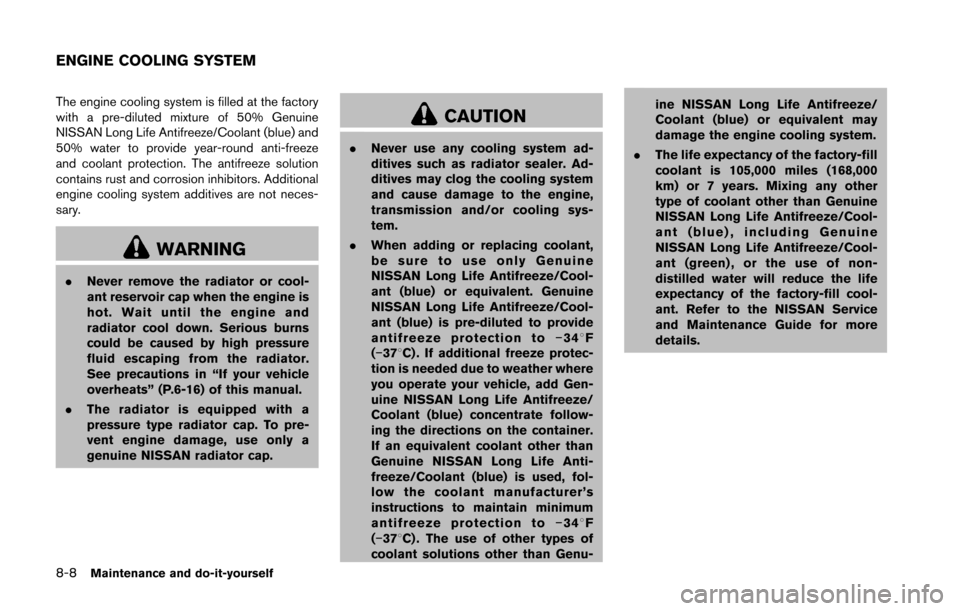
8-8Maintenance and do-it-yourself
The engine cooling system is filled at the factory
with a pre-diluted mixture of 50% Genuine
NISSAN Long Life Antifreeze/Coolant (blue) and
50% water to provide year-round anti-freeze
and coolant protection. The antifreeze solution
contains rust and corrosion inhibitors. Additional
engine cooling system additives are not neces-
sary.
WARNING
.Never remove the radiator or cool-
ant reservoir cap when the engine is
hot. Wait until the engine and
radiator cool down. Serious burns
could be caused by high pressure
fluid escaping from the radiator.
See precautions in “If your vehicle
overheats” (P.6-16) of this manual.
. The radiator is equipped with a
pressure type radiator cap. To pre-
vent engine damage, use only a
genuine NISSAN radiator cap.
CAUTION
.Never use any cooling system ad-
ditives such as radiator sealer. Ad-
ditives may clog the cooling system
and cause damage to the engine,
transmission and/or cooling sys-
tem.
. When adding or replacing coolant,
be sure to use only Genuine
NISSAN Long Life Antifreeze/Cool-
ant (blue) or equivalent. Genuine
NISSAN Long Life Antifreeze/Cool-
ant (blue) is pre-diluted to provide
antifreeze protection to �í348 F
(�í378C) . If additional freeze protec-
tion is needed due to weather where
you operate your vehicle, add Gen-
uine NISSAN Long Life Antifreeze/
Coolant (blue) concentrate follow-
ing the directions on the container.
If an equivalent coolant other than
Genuine NISSAN Long Life Anti-
freeze/Coolant (blue) is used, fol-
low the coolant manufacturer’s
instructions to maintain minimum
antifreeze protection to �í348 F
(�í378C) . The use of other types of
coolant solutions other than Genu- ine NISSAN Long Life Antifreeze/
Coolant (blue) or equivalent may
damage the engine cooling system.
. The life expectancy of the factory-fill
coolant is 105,000 miles (168,000
km) or 7 years. Mixing any other
type of coolant other than Genuine
NISSAN Long Life Antifreeze/Cool-
ant (blue) , including Genuine
NISSAN Long Life Antifreeze/Cool-
ant (green) , or the use of non-
distilled water will reduce the life
expectancy of the factory-fill cool-
ant. Refer to the NISSAN Service
and Maintenance Guide for more
details.
ENGINE COOLING SYSTEM
Page 358 of 428
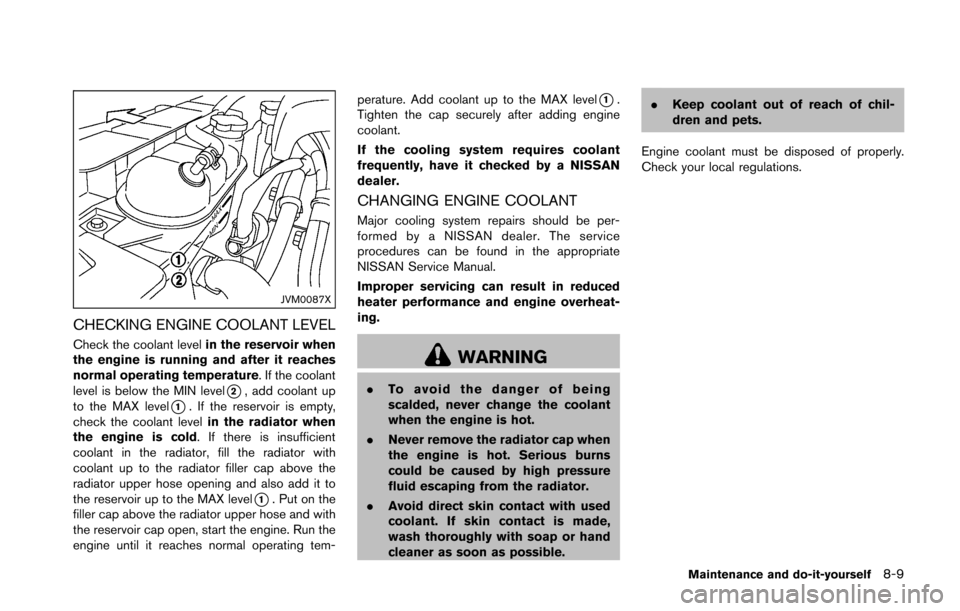
JVM0087X
CHECKING ENGINE COOLANT LEVEL
Check the coolant levelin the reservoir when
the engine is running and after it reaches
normal operating temperature. If the coolant
level is below the MIN level
*2, add coolant up
to the MAX level
*1. If the reservoir is empty,
check the coolant level in the radiator when
the engine is cold. If there is insufficient
coolant in the radiator, fill the radiator with
coolant up to the radiator filler cap above the
radiator upper hose opening and also add it to
the reservoir up to the MAX level
*1. Put on the
filler cap above the radiator upper hose and with
the reservoir cap open, start the engine. Run the
engine until it reaches normal operating tem- perature. Add coolant up to the MAX level
*1.
Tighten the cap securely after adding engine
coolant.
If the cooling system requires coolant
frequently, have it checked by a NISSAN
dealer.
CHANGING ENGINE COOLANT
Major cooling system repairs should be per-
formed by a NISSAN dealer. The service
procedures can be found in the appropriate
NISSAN Service Manual.
Improper servicing can result in reduced
heater performance and engine overheat-
ing.
WARNING
. To avoid the danger of being
scalded, never change the coolant
when the engine is hot.
. Never remove the radiator cap when
the engine is hot. Serious burns
could be caused by high pressure
fluid escaping from the radiator.
. Avoid direct skin contact with used
coolant. If skin contact is made,
wash thoroughly with soap or hand
cleaner as soon as possible. .
Keep coolant out of reach of chil-
dren and pets.
Engine coolant must be disposed of properly.
Check your local regulations.
Maintenance and do-it-yourself8-9
Page 393 of 428
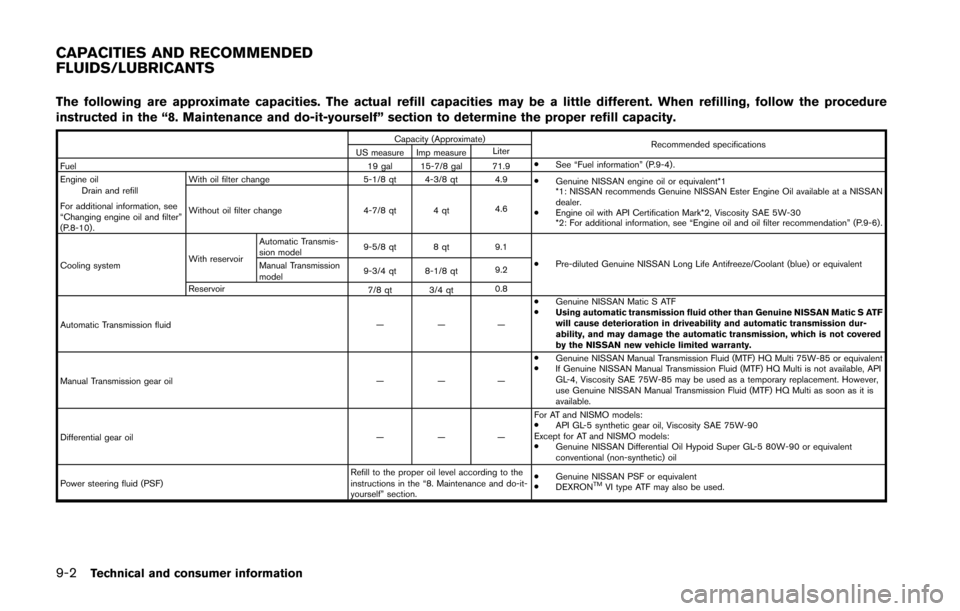
9-2Technical and consumer information
The following are approximate capacities. The actual refill capacities may be a little different. When refilling, follow the procedure
instructed in the “8. Maintenance and do-it-yourself” section to determine the proper refill capacity.
Capacity (Approximate)Recommended specifications
US measure Imp measure Liter
Fuel 19 gal 15-7/8 gal 71.9.
See “Fuel information” (P.9-4) .
Engine oil Drain and refill
For additional information, see
“Changing engine oil and filter”
(P.8-10). With oil filter change
5-1/8 qt 4-3/8 qt 4.9
.
Genuine NISSAN engine oil or equivalent*1
*1: NISSAN recommends Genuine NISSAN Ester Engine Oil available at a NISSAN
dealer.
. Engine oil with API Certification Mark*2, Viscosity SAE 5W-30
*2: For additional information, see “Engine oil and oil filter recommendation” (P.9-6) .
Without oil filter change
4-7/8 qt 4 qt4.6
Cooling system With reservoirAutomatic Transmis-
sion model
9-5/8 qt 8 qt
9.1
.Pre-diluted Genuine NISSAN Long Life Antifreeze/Coolant (blue) or equivalent
Manual Transmission
model 9-3/4 qt 8-1/8 qt
9.2
Reservoir 7/8 qt 3/4 qt0.8
Automatic Transmission fluid ———.
Genuine NISSAN Matic S ATF
. Using automatic transmission fluid other than Genuine NISSAN Matic S ATF
will cause deterioration in driveability and automatic transmission dur-
ability, and may damage the automatic transmission, which is not covered
by the NISSAN new vehicle limited warranty.
Manual Transmission gear oil ———.
Genuine NISSAN Manual Transmission Fluid (MTF) HQ Multi 75W-85 or equivalent
. If Genuine NISSAN Manual Transmission Fluid (MTF) HQ Multi is not available, API
GL-4, Viscosity SAE 75W-85 may be used as a temporary replacement. However,
use Genuine NISSAN Manual Transmission Fluid (MTF) HQ Multi as soon as it is
available.
Differential gear oil ———For AT and NISMO models:
.
API GL-5 synthetic gear oil, Viscosity SAE 75W-90
Except for AT and NISMO models:
. Genuine NISSAN Differential Oil Hypoid Super GL-5 80W-90 or equivalent
conventional (non-synthetic) oil
Power steering fluid (PSF) Refill to the proper oil level according to the
instructions in the “8. Maintenance and do-it-
yourself” section..
Genuine NISSAN PSF or equivalent
. DEXRON
TMVI type ATF may also be used.
CAPACITIES AND RECOMMENDED
FLUIDS/LUBRICANTS
Page 421 of 428
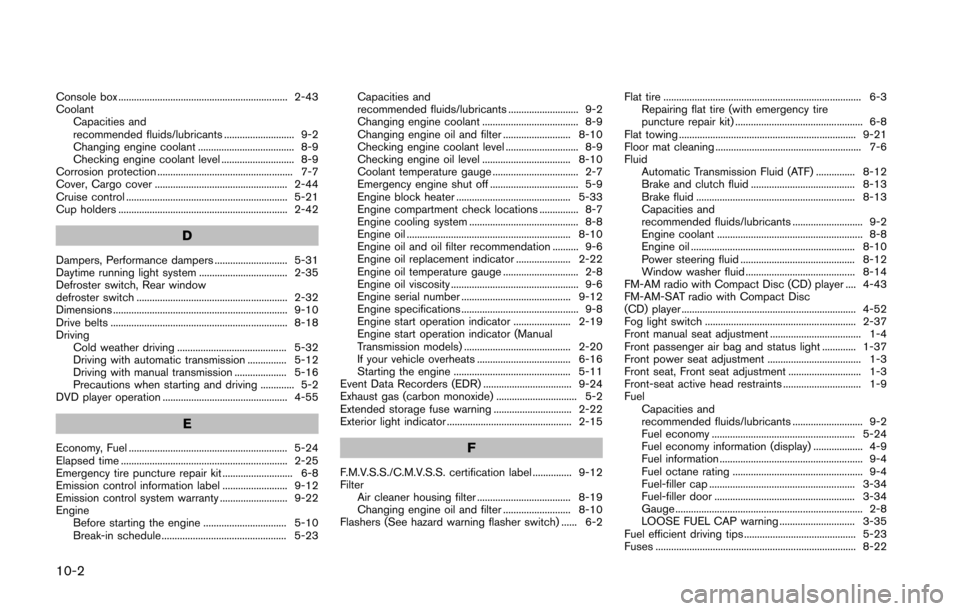
10-2
Console box ................................................................. 2-43
CoolantCapacities and
recommended fluids/lubricants ........................... 9-2
Changing engine coolant ..................................... 8-9
Checking engine coolant level ............................ 8-9
Corrosion protection .................................................... 7-7
Cover, Cargo cover ................................................... 2-44
Cruise control .............................................................. 5-21
Cup holders ................................................................. 2-42
D
Dampers, Performance dampers ............................ 5-31
Daytime running light system .................................. 2-35
Defroster switch, Rear window
defroster switch .......................................................... 2-32
Dimensions ................................................................... 9-10
Drive belts .................................................................... 8-18
Driving Cold weather driving .......................................... 5-32
Driving with automatic transmission ............... 5-12
Driving with manual transmission .................... 5-16
Precautions when starting and driving ............. 5-2
DVD player operation ................................................ 4-55
E
Economy, Fuel ............................................................. 5-24
Elapsed time ................................................................ 2-25
Emergency tire puncture repair kit ........................... 6-8
Emission control information label ......................... 9-12
Emission control system warranty .......................... 9-22
Engine Before starting the engine ................................ 5-10
Break-in schedule ................................................ 5-23 Capacities and
recommended fluids/lubricants ........................... 9-2
Changing engine coolant ..................................... 8-9
Changing engine oil and filter .......................... 8-10
Checking engine coolant level ............................ 8-9
Checking engine oil level .................................. 8-10
Coolant temperature gauge ................................. 2-7
Emergency engine shut off .................................. 5-9
Engine block heater ............................................ 5-33
Engine compartment check locations ............... 8-7
Engine cooling system .......................................... 8-8
Engine oil ............................................................... 8-10
Engine oil and oil filter recommendation .......... 9-6
Engine oil replacement indicator ..................... 2-22
Engine oil temperature gauge ............................. 2-8
Engine oil viscosity ................................................. 9-6
Engine serial number .......................................... 9-12
Engine specifications ............................................. 9-8
Engine start operation indicator ...................... 2-19
Engine start operation indicator (Manual
Transmission models) ......................................... 2-20
If your vehicle overheats .................................... 6-16
Starting the engine ............................................. 5-11
Event Data Recorders (EDR) .................................. 9-24
Exhaust gas (carbon monoxide) ............................... 5-2
Extended storage fuse warning .............................. 2-22
Exterior light indicator ................................................ 2-15F
F.M.V.S.S./C.M.V.S.S. certification label ............... 9-12
Filter Air cleaner housing filter .................................... 8-19
Changing engine oil and filter .......................... 8-10
Flashers (See hazard warning flasher switch) ...... 6-2 Flat tire ............................................................................ 6-3
Repairing flat tire (with emergency tire
puncture repair kit) ................................................. 6-8
Flat towing .................................................................... 9-21
Floor mat cleaning ........................................................ 7-6
Fluid Automatic Transmission Fluid (ATF) ............... 8-12
Brake and clutch fluid ........................................ 8-13
Brake fluid ............................................................. 8-13
Capacities and
recommended fluids/lubricants ........................... 9-2
Engine coolant ........................................................ 8-8
Engine oil ............................................................... 8-10
Power steering fluid ............................................ 8-12
Window washer fluid .......................................... 8-14
FM-AM radio with Compact Disc (CD) player .... 4-43
FM-AM-SAT radio with Compact Disc
(CD) player ................................................................... 4-52
Fog light switch .......................................................... 2-37
Front manual seat adjustment ................................... 1-4
Front passenger air bag and status light ............. 1-37
Front power seat adjustment .................................... 1-3
Front seat, Front seat adjustment ............................ 1-3
Front-seat active head restraints .............................. 1-9
Fuel Capacities and
recommended fluids/lubricants ........................... 9-2
Fuel economy ....................................................... 5-24
Fuel economy information (display) ................... 4-9
Fuel information ....................................................... 9-4
Fuel octane rating .................................................. 9-4
Fuel-filler cap ........................................................ 3-34
Fuel-filler door ...................................................... 3-34
Gauge ........................................................................ 2-8
LOOSE FUEL CAP warning ............................. 3-35
Fuel efficient driving tips ........................................... 5-23
Fuses ............................................................................. 8-22